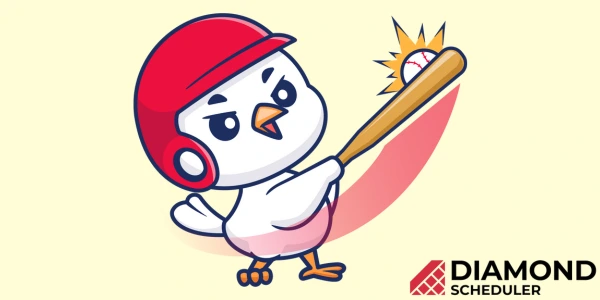
Softball's Infield Fly Rule: Comprehensive Guide
The infield fly rule in softball is a tricky one to understand and put into play. Whether you're a league owner, player, or coach, knowing and understanding this rather contentious rule of play is important and necessary, as it can be the difference between winning or losing the Little League World Series or a competitive game of softball.
First introduced in 1895, the infield fly rule is the best safeguard against forced outs and other tactical trickery that could see the opposing team being given the upper hand. But what exactly is the infield fly rule, and how does it make a difference in the fairness of the game?
Join us as we embark on a journey to uncover all there is to know about the infield fly rule and how to incorporate it into your gameplay.

The basics of the infield fly rule
Before we get carried away with the technicalities of the infield fly rule, it's important to understand what it means. So, what is the infield fly rule?
This rule states that a fair fly ball can be caught by infielders, pitchers, or even a catcher using ordinary effort. Based on the discretion of the umpire, the rule also states that runners must be on 1st and 2nd base or 1st, 2nd, and 3rd bases.
Sounds a little complicated, right? Let's simplify it a bit more so that there is absolutely no ambiguity or misconceptions about what the infield fly rule entails.
Differentiating between infield and outfield fly balls
To understand the concept of the infield fly rule, it is necessary to first know the difference between an infield and outfield fly ball:
Infield fly ball: An infield fly ball can be fairly caught by infielders with ordinary effort. The player should not be demonstrating any extra effort or activity to catch the ball.
Outfield fly ball: An outfield fly ball is much like the infield fly ball but is caught by the outfielders with ordinary effort.
Makes sense now, doesn't it?
Now that we have that topic covered, we can move right along.
Infield fly rule conditions
While this rule is at the discretion of the umpire, the official rules of baseball outline a few conditions that must be met for the infield fly rule to be allowed.
Here are the conditions:
There must be less than two outs
Runners must be placed on 1st and 2nd bases, or 1st, 2nd, and 3rd bases (fair ball)
The infielder must be able to catch the ball hit using ordinary effort
An infield fly ball cannot be a "bunt" (ordinary foul ball) or "line drive" (the ball hit is fast and straight)
If the above conditions are not met, the umpire may not call for the infield fly rule to take effect.
Umpire's infield rule | Umpire ClassroomThe rationale behind the infield fly rule
Known as America's pastime, baseball is not only a competitive sport, its players and fans are very passionate about every aspect of gameplay. Baseball being on the big stages of MLB, The College World Series, or The Big 12 Baseball Tournament means the display of fair gameplay is important for the integrity of the game.
The sole purpose of the infield fly rule is to prevent an unfair disadvantage when a pop-up or fly ball could possibly lead to the opposing team exploiting the rules.
There are a few other advantages of the rule, which are as follows:
Advantage 1: Prevents double or triple play
Implementing the infield fly rule prevents infielders from intentionally dropping the pop-up or fly ball, then picking it up again and tagging the base.
This is known as a double play. And while it is not against the rules, it is seen as an unfair disadvantage for the opposition. Multiple outs are not always advantageous to force play.
Advantage 2: Encourages fair play
Sportsmanship and fair play go hand in hand in a game like baseball. These are only possible when league owners, coaches, and players understand and follow the rules.
Ensuring that all players know the ins and outs of the infield fly rule will only encourage fair play.
Advantage 3: Maintains balance
No game can survive without balance, and that's exactly what the infield fly rule brings for both the offense and the defense - balance. Baseball is a game of strategy and relies on scoring opportunities and preventing the opposing team from getting runs.
The infield fly rule ensures that neither side has the chance to gain an unfair advantage.
Advantage 4: Enhances the skill of players
Skilled players can easily catch a pop-up or fly ball in the infield. This is clear to see when the infield fly rule is called by the umpire, allowing these players to do what they do best.
Advantage 5: Discourages deliberate drops or misplays
The very essence of the infield fly rule is to prevent infielders from deliberately dropping balls that could have been caught by these players.
The infield fly rule is called by the umpire and is necessary to ensure fair gameplay between the offensive and defensive teams.
Advantage 6: Enhances the flow of the game
Baseball or softball games could easily go on longer than needed if the infield fly rule were not introduced.
Players often pull out all the stops to prolong a game, using deliberate drops and tap-out attempts to ensure that the game goes on longer than it needs to.
The infield fly rule puts a stop to any of this and is considered an automatic out in situations where an infield fly could be allowed.
Scenarios and examples of the infield fly rule
To further understand this rule and why it is sometimes put into play, let's look at a few typical situations where it could be implemented and a few real-life examples where the infield fly rule was used.
Situation one
In our first situation, imagine that there are runners in place on first and second base. There is currently only one player out.
The batter has just hit a high-fly ball towards a section of the field that is not attainable to infielders without extraordinary effort. In this case, it would be the shallow left field. The umpire calls an infield fly.
This move prevents a double play, where the infielder of the defensive team would catch the ball and tag the runner on second base.
Situation two
The second situation is much like the first, seeing runners placed on first and second base with one out. The batter hits a high pop-up ball towards the pitcher.
The umpire calls an infield fly. By doing this, he prevents the pitcher from dropping the ball (note the intentional drop rule), picking it up again, and throwing it to third base.
This maneuver is called a tag out and results in an unfair advantage for the offense.
Situation three
In our third and final situation, at least two runners are once again placed on first and second bases with one out.
In this scenario, the batter hits a high pop-up ball toward the third baseman, who, without an infield fly being called by the umpire, would intentionally drop the ball, pick it up, and throw it to second base.
This move is known as a force-out and is prevented by using the infield fly rule.
Now that we have looked at ways in which this rule can improve the fairness of the game for both the offense and defense, let's look at some real-life situations in Major League Baseball in which the infield fly rule was used.
The most talked-about game that saw the infield fly rule being implemented took place in 2012 when the Atlanta Braves took on the St. Louis Cardinals in the first National League Wild Card Game of the season.
The winner of this game would go on to take part in the NL Divisional Series, making it an important game that saw both the offense and defense try and pull out all the stops to take the lead and win the game.
Atlanta had runners on first and second base, with fewer than two outs when batsman Andrelton Simmons hit a pop-fly to the left field.
Any player would know that this would likely present an easy double play had the umpire not called an infield fly to be implemented. This, in turn, resulted in Simmons being called out and the other runners on first and second advancing to the home plate with two out.
In case you're wondering, the Cardinals won the game with a score of 6-3, advancing them into the NL Divisional Series in Major League Baseball.
Mets take advantage of infield fly rule | MLBThe role and responsibilities of the umpire in the infield fly rule
It is time to look at the role and the responsibilities of the umpire as they call for the infield fly rule to be implemented.
Here are a few of the responsibilities:
To understand the current situation and why the infield fly rule is a good option
To determine what is and what is not fair territory
To judge the "ordinary" effort that it would take the infielders, catchers, or other players to catch the pop-up or shallow fly ball
To implement and enforce the infield fly rule on fairgrounds
To give a visual and vocal signal that the rule is in play by placing their arm straight
To call the batter out
The umpire is best placed to make the call for an infield fly rule to be implemented and must be the one to enforce all aspects of the rule. The rule is at the umpire's discretion.

Infield fair fly ball rule strategies for players
Let's look at how both the offense and defense can react to or execute the infield fly rule to maintain fairness and allow the game to continue unhinged.
It is important to remember that the rule is there to protect runners and not to give a free out to the defense.
Once the infield fly rule has been called, it is the responsibility of the defense to catch the ball easily and not deliberately drop it, only to pick it up again and proceed to a double play or tag maneuver.
They should immediately throw the ball, while the offense would continue with their move along the bases, while the batsman would be called out.
Remember, the infield fly rule exists to ensure fair gameplay and not to make other baseball rules null and void. All the runners should advance to the next base as usual, with the batter being called out as per the infield fly rules.
Baseball vs. softball: Does the infield fly rule differ in these sports?
The infield fly rule is exactly the same for both slow pitch, softball, and baseball. While the rule saw a few changes over the years, the standard playing rules for baseball and softball include the infield fly rule.
Frequently asked questions
There are a few misconceptions about the infield fly rule that we need to clear up.
And there is no better way to do it than by answering a few burning questions about this rule and its intricacies in our FAQ section.
Without further ado, let's look at the questions.
Does the game come to a halt when the infield fly rule is called?
No. Runners should continue running. With the infield fly rule, runners are not forced to advance because the batter is automatically out. The game will continue as normal as runners advance.
How many runners should be placed on bases for an infield fly rule to be called?
Runners could be placed on 1st and 2nd base or 1st, 2nd, and 3rd base with one player already out.
What is the biggest advantage of the infield fly rule?
The infield fly rule ensures fair gameplay for both the offense and defense in any baseball or softball game.
What is defined as a fly ball when judging the infield fly rule?
A fly ball is a batted ball hit high into the air. For the infield fly rule in baseball rules, this can't be a fly ball from an attempted foul ball or bunt. An infielder must be able to catch the ball using ordinary effort, as the umpire calls it.
Recap
The infield fly rule is not only a rule that helps ensure fair gameplay but is also one of the oldest rules in the book.
The rule is called when a fair fly ball can be caught by infielders, pitchers, or catchers with ordinary effort but requires a few conditions to be met before the umpire can use their discretion and call for the rule to be put into play.
In this guide, we have looked at the ins and outs of the infield fly rule, the conditions that must be met, and how the defense and offense should adapt their gameplay strategy to meet the terms of the rule.
Take a look at our FAQs that cover the tricky but most asked questions, and take note of the umpire's role in the infield fly rule.
Thalia Oosthuizen has been writing in a professional capacity for over a decade. Her love for sports has led her down the path of sports writing, where her passion and skills combine. Thalia is a runner, cyclist, and swimmer, and enjoys playing tennis and hockey. Her favorite sports teams include Chelsea F.C. and the Georgian Lions Rugby Club.
About Diamond Scheduler
Diamond Scheduler makes planning your league’s complex season easier than ever. Create your first schedule in minutes for free. It's fast, fun, and simple.



